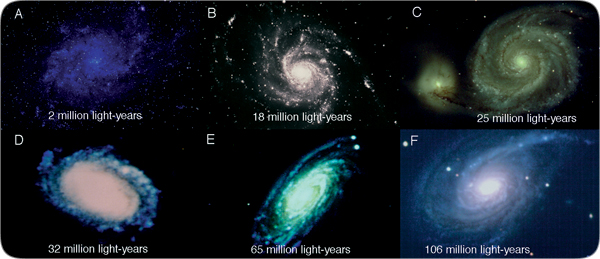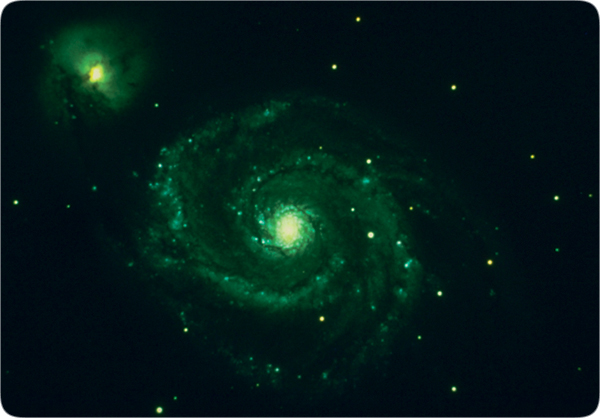Show your support by donating any amount. (Note: We are still technically a for-profit company, so your
contribution is not tax-deductible.)
PayPal Acct:  Feedback:
Feedback: 
Donate to VoyForums (PayPal):
| [ Login ] [ Contact Forum Admin ] [ Main index ] [ Post a new message ] [ Search | Check update time | Archives: 1, 2, [3], 4, 5, 6, 7, 8, 9, 10 ] |
Evolutionists now admit that galaxies cannot evolve from one type to another (a). There are also good reasons why natural processes cannot form galaxies (b). Furthermore, if spiral galaxies were billions of years old, their arms or bars would be severely twisted (c).

Figure 219: Spiral Galaxies. The arms in these six representative spiral galaxies have about the same amount of twist. Their distances from Earth are shown in light-years. (One light-year, the distance light travels in one year, equals 5,879,000,000,000 miles.) For the light from all galaxies to arrive at Earth tonight, the more distant galaxies, which had to release their light long before the closer galaxies, did not have as much time to rotate and twist their arms. Therefore, farther galaxies should have less twist. Of course, if light traveled millions of times faster in the past—or if space and its light were stretched out during the creation week, as is proposed on pages 396–401
— the farthest galaxies did not have to send their light long before the nearest galaxies. Spiral galaxies should have similar twists. This turns out to be the case.21
The galaxies are: A) M33 or NGC 598; B) M101 or NGC 5457; C) M51 or NGC 5194; D) NGC 4559; E) M88 or NGC 4501; and F) NGC 772. All distances are taken from R. Brent Tully, Nearby Galaxies Catalog (New York: Cambridge University Press, 1988)
Because they have maintained their shape, either galaxies are young, or unknown physical phenomena are occurring within galaxies (d). Even structures composed of galaxies are now known to be so amazingly large and so elongated that they could not have formed by slow gravitational attraction. (e). Slow, natural processes cannot form such huge galactic structures; rapid, supernatural processes may have.

Figure 27: Spiral Galaxies.
a. “There is much doubt, however, that galaxies evolve from one type to another at all.” George Abell, Exploration of the Universe, 2nd edition (New York: Holt, Rinehart, and Winston, 1969), p. 629.
“Our conclusions, then, are that the sequence of the classification of galaxies is not an evolutionary sequence ...” Paul W. Hodge, The Physics and Astronomy of Galaxies and Cosmology (New York: McGraw-Hill, 1966), p. 122.
b. “The problem of explaining the existence of galaxies has proved to be one of the thorniest in cosmology. By all rights, they just shouldn’t be there, yet there they sit. It’s hard to convey the depth of frustration that this simple fact induces among scientists.” Trefil, The Dark Side of the Universe, p. 55.
Trefil explains the basis for this frustration in his fourth chapter entitled, “Five Reasons Why Galaxies Can’t Exist.”
“We cannot even show convincingly how galaxies, stars, planets, and life arose in the present universe.” Michael Rowan-Robinson, “Review of the Accidental Universe,” New Scientist, Vol. 97, 20 January 1983, p. 186.
“A completely satisfactory theory of galaxy formation remains to be formulated.” Joseph Silk, The Big Bang (San Francisco: W. H. Freeman and Co., 1980), p. 22.
“The theory of the formation of galaxies is one of the great outstanding problems of astrophysics, a problem that today seems far from solution.” Steven Weinberg, The First Three Minutes (New York: Bantom Books, Inc., 1977), p. 68.
Fifty cosmologists attended a conference on galaxy formation. After summarizing much observational data, two of the most respected authorities optimistically estimated the probability that any existing theory on galaxy formation is correct is about 1 out of 100. [See P. J. E. Peebles and Joseph Silk, “A Cosmic Book,” Nature, Vol. 335, 13 October 1988, pp. 601–606.]
c. Hodge, p. 123.
d. Harold S. Slusher, “Clues Regarding the Age of the Universe,” ICR Impact, No. 19, January 1975, pp. 2–3.
Steidl, pp. 161–187.
e. “In its simplest form, the Big Bang scenario doesn’t look like a good way to make galaxies. It allows too little time for the force of gravity by itself to gather ordinary matter—neutrons, protons and electrons—into the patterns of galaxies seen today. Yet the theory survives for want of a better idea.” Peterson, “Seeding the Universe,” p. 184.
“It [the Great Wall, composed of tens of thousands of galaxies] is far too large and too massive to have formed by the mutual gravitational
attraction of its member galaxies.” M. Mitchell Waldrop, “Astronomers Go Up Against the Great Wall,” Science, Vol. 2 46, 17 November 1989, p. 885. [See also Margaret J. Geller and John P. Huchra, “Mapping the Universe,” Science, Vol. 246, 17 November 1989, pp. 897–903.]
[From “In the Beginning” by Walt Brown ]
[
Next Thread |
Previous Thread |
Next Message |
Previous Message
]
|
Forum timezone: GMT-8 VF Version: 3.00b, ConfDB: Before posting please read our privacy policy. VoyForums(tm) is a Free Service from Voyager Info-Systems. Copyright © 1998-2019 Voyager Info-Systems. All Rights Reserved. |